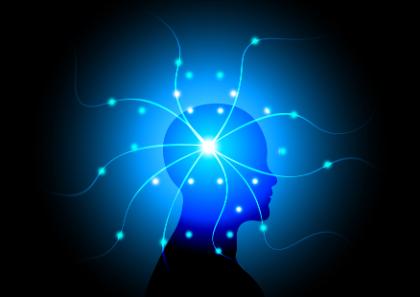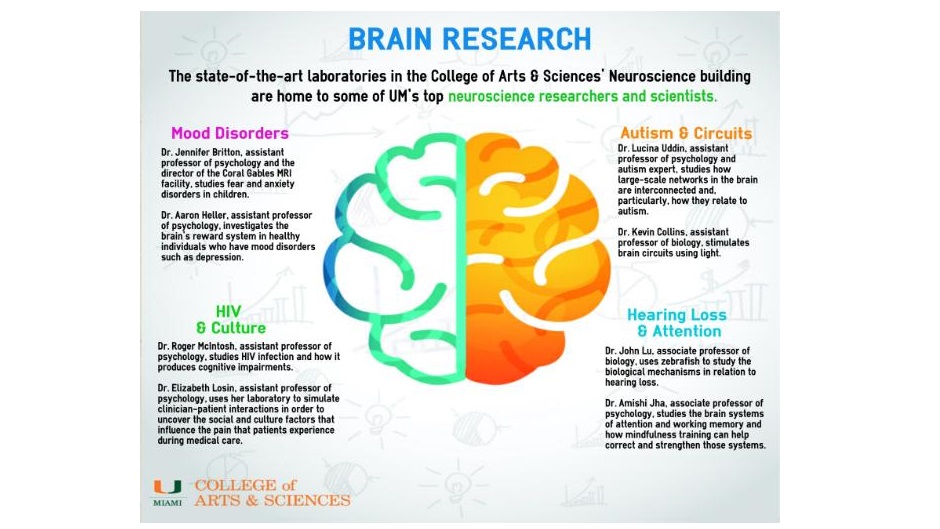Imagine you are in your doctor’s office and about to get the flu shot. If you trust your doctor, and you feel more culturally connected to your doctor, will the shot hurt less? And if so, why? It’s a scenario posed by Dr. Elizabeth Losin, assistant professor of psychology at the University of Miami College of Arts & Sciences. It is also a situation she explores in her Social & Cultural Neuroscience Laboratory at the Neuroscience building where interdisciplinary and collaborative neuroscience brain research happens on a day-to-day basis.
One of the most important features of the Neuroscience building, located in the College of Arts & Sciences at the Coral Gables campus, is its functional magnetic resonance imaging (fMRI) research laboratory where UM scientists and researchers focus on specific neurobiology and neuropsychology areas of study, from anxiety disorders to language development and attention disorders.
The state-of-the-art laboratories in the Neuroscience building are home to some of UM’s top neuroscience researchers and scientists, like Dr. Lucina Uddin, who studies how large-scale networks in the brain are interconnected and, particularly, how they relate to autism; Dr. Jennifer Britton, the director of the Coral Gables MRI facility, who studies fear and anxiety disorders in children; Dr. Aaron Heller, who investigates the brain’s reward system in healthy individuals and individuals who have mood disorders such as depression; Dr. John Lu, who uses zebrafish to study the biological mechanisms in relation to hearing loss; Dr. Amishi Jha, who studies the brain systems of attention and working memory, and how mindfulness training can help correct and strengthen those systems; Dr. Roger McIntosh, who studies HIV infection and how it produces cognitive impairments; and Dr. Kevin Collins, who stimulates brain circuits using light.
“When the Neuroscience building was completed, it was a ‘transformational’ occurrence because it brought together neuroscientists from the Coral Gables campus and The Leonard M. Miller School of Medicine,” says Dr. Philip McCabe, professor and chair of psychology at the College of Arts & Sciences. “The University has always had neuroscientists, but they were always in different departments and not connecting.”
The academic outlook on neuroscience shifted in 1992 when the University created the university-wide Neuroscience Ph.D. Program; in 2001, the undergraduate neuroscience major was established as an interdisciplinary program in the College of Arts & Sciences (A&S).
“The undergraduate program is very collaborative and not just in the College,” said Dr. McCabe. “When the undergraduate neuroscience program was created, one of the stipulations was that faculty from the medical school had to be involved.”
 |
Dr. Helen Bramlett, director of the undergraduate neuroscience program at A&S and professor of neurological surgery at the Miller School of Medicine, says one of the major features of the program is helping place students in faculty labs to conduct research. “The type of research they are exposed to is very wide,” she said. “It runs from cells all the way up to clinical research, and depends on what the students want to do so we leave that up to them because we want them to go to a lab that they are happy with.”
In Dr. Losin’s lab, she simulates clinician-patient interactions in order to uncover the social and cultural factors that influence the pain that patients experience during medical care. During these simulations, researchers act as clinicians and induce pain in willing and healthy participants both in and out of the MRI scanner. “We can monitor many things, such as brain activity, facial expressions, and physiological signs like palm sweating. This gives us the ability to look under the hood and see what’s going in the body and brain in addition to what somebody is telling us about the pain they are feeling,” said Dr. Losin.
Her research on culture, the brain, and pain is driven by three overarching questions: How does culture shape the brain? How does cultural information get into the brain? How does culture influence health?
Dr. Losin explains: “What we now know about pain is that there are not only messages being transmitted out from the body and into the brain but in the other direction as well, from the brain to the body. A lot of factors such as what we expect about pain, how we react to pain, and other previous negative experiences can send messages down to the body that either turn up or turn down the volume on pain, and many of those factors are social and cultural.”
“There is a lot we don’t know about how the brain works. For example, there are many cultural and socioeconomic factors that can influence brain function, so by doing brain imaging here [at UM] within this very diverse community, we can start to understand new things about brain mechanisms associated with feeling pain and the social and cultural factors that influence them. This knowledge is especially important since pain is a big public health problem and a contributor to racial and ethnic health disparities,” said Dr. Losin.
“Neuroscience is an area of strength at the University,” said Dr. McCabe. “And with our recent hires in the College of Arts & Sciences, we have expanded the range of translational research into this very important field of science.”
December 10, 2015

